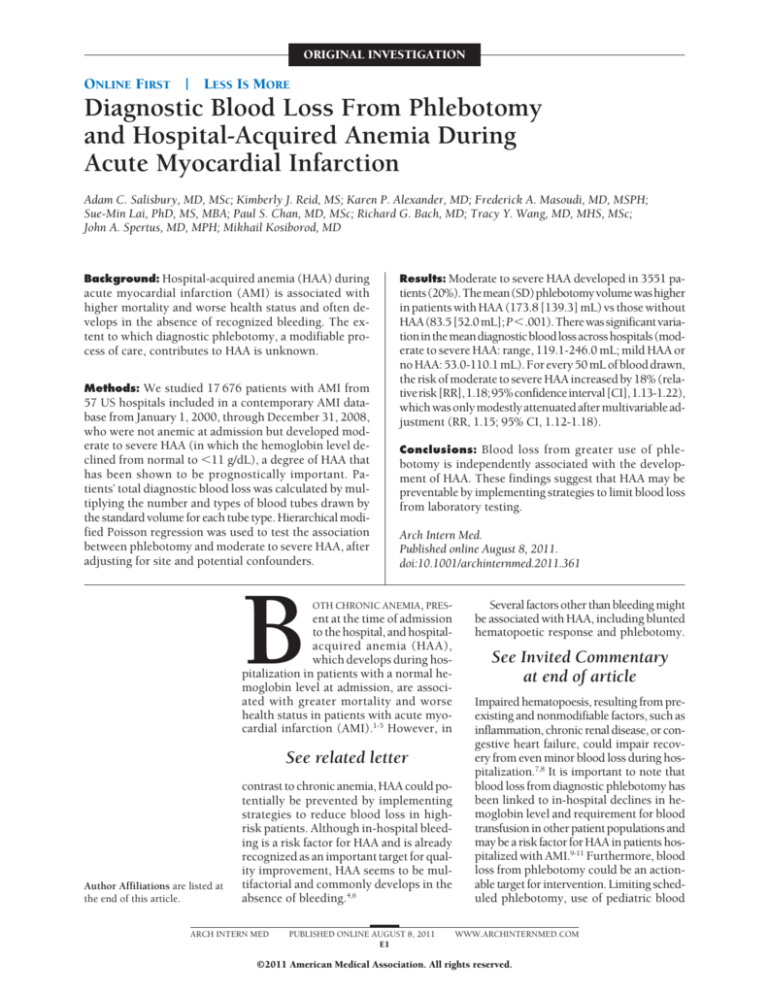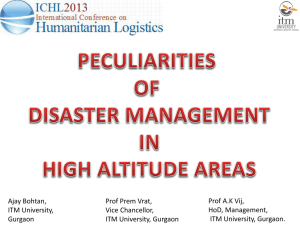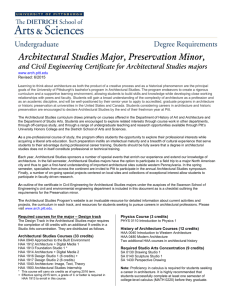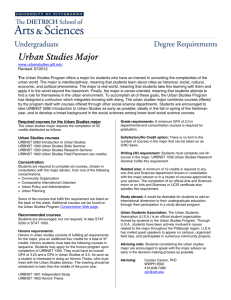
ORIGINAL INVESTIGATION
ONLINE FIRST
|
LESS IS MORE
Diagnostic Blood Loss From Phlebotomy
and Hospital-Acquired Anemia During
Acute Myocardial Infarction
Adam C. Salisbury, MD, MSc; Kimberly J. Reid, MS; Karen P. Alexander, MD; Frederick A. Masoudi, MD, MSPH;
Sue-Min Lai, PhD, MS, MBA; Paul S. Chan, MD, MSc; Richard G. Bach, MD; Tracy Y. Wang, MD, MHS, MSc;
John A. Spertus, MD, MPH; Mikhail Kosiborod, MD
Background: Hospital-acquired anemia (HAA) during
acute myocardial infarction (AMI) is associated with
higher mortality and worse health status and often develops in the absence of recognized bleeding. The extent to which diagnostic phlebotomy, a modifiable process of care, contributes to HAA is unknown.
Methods: We studied 17 676 patients with AMI from
57 US hospitals included in a contemporary AMI database from January 1, 2000, through December 31, 2008,
who were not anemic at admission but developed moderate to severe HAA (in which the hemoglobin level declined from normal to ⬍11 g/dL), a degree of HAA that
has been shown to be prognostically important. Patients’ total diagnostic blood loss was calculated by multiplying the number and types of blood tubes drawn by
the standard volume for each tube type. Hierarchical modified Poisson regression was used to test the association
between phlebotomy and moderate to severe HAA, after
adjusting for site and potential confounders.
B
Results: Moderate to severe HAA developed in 3551 patients(20%).Themean(SD)phlebotomyvolumewashigher
in patients with HAA (173.8 [139.3] mL) vs those without
HAA (83.5 [52.0 mL]; P⬍.001). There was significant variation in the mean diagnostic blood loss across hospitals (moderate to severe HAA: range, 119.1-246.0 mL; mild HAA or
no HAA: 53.0-110.1 mL). For every 50 mL of blood drawn,
the risk of moderate to severe HAA increased by 18% (relativerisk[RR],1.18;95%confidenceinterval[CI],1.13-1.22),
which was only modestly attenuated after multivariable adjustment (RR, 1.15; 95% CI, 1.12-1.18).
Conclusions: Blood loss from greater use of phle-
botomy is independently associated with the development of HAA. These findings suggest that HAA may be
preventable by implementing strategies to limit blood loss
from laboratory testing.
Arch Intern Med.
Published online August 8, 2011.
doi:10.1001/archinternmed.2011.361
OTH CHRONIC ANEMIA, PRES-
ent at the time of admission
to the hospital, and hospitalacquired anemia (HAA),
which develops during hospitalization in patients with a normal hemoglobin level at admission, are associated with greater mortality and worse
health status in patients with acute myocardial infarction (AMI).1-5 However, in
See related letter
Author Affiliations are listed at
the end of this article.
contrast to chronic anemia, HAA could potentially be prevented by implementing
strategies to reduce blood loss in highrisk patients. Although in-hospital bleeding is a risk factor for HAA and is already
recognized as an important target for quality improvement, HAA seems to be multifactorial and commonly develops in the
absence of bleeding.4,6
ARCH INTERN MED
PUBLISHED ONLINE AUGUST 8, 2011
E1
Several factors other than bleeding might
be associated with HAA, including blunted
hematopoetic response and phlebotomy.
See Invited Commentary
at end of article
Impaired hematopoesis, resulting from preexisting and nonmodifiable factors, such as
inflammation, chronic renal disease, or congestive heart failure, could impair recovery from even minor blood loss during hospitalization.7,8 It is important to note that
blood loss from diagnostic phlebotomy has
been linked to in-hospital declines in hemoglobin level and requirement for blood
transfusion in other patient populations and
may be a risk factor for HAA in patients hospitalized with AMI.9-11 Furthermore, blood
loss from phlebotomy could be an actionable target for intervention. Limiting scheduled phlebotomy, use of pediatric blood
WWW.ARCHINTERNMED.COM
©2011 American Medical Association. All rights reserved.
tubes, and more frequent use of stored serum specimens
in high-risk patients may all minimize diagnostic blood
loss (DBL)12-14 and could reduce the incidence and severity of HAA.
To our knowledge, the relationship between diagnostic phlebotomy and the risk of HAA has not been previously explored in patients with AMI. Accordingly, we used
Cerner Corp’s (Kansas City, Missouri) Health Facts, an
electronic medical record database, to evaluate the association between DBL and HAA in an unselected cohort of patients with AMI hospitalized in 57 medical centers. Health Facts provided an ideal opportunity to address
this hypothesis since the database contains detailed information on the frequency and type of laboratory testing, as well as patients’ hemoglobin levels, across diverse group of US hospitals.
METHODS
DATA SOURCE
To identify the association between phlebotomy and HAA, we used
the Cerner Corp’s Health Facts database (see the “Methods” section of the eAppendix;http://www.archinternmed.com).15,16 The
database captured deidentified data from the Cerner electronic
medical record for patients admitted to participating hospitals from
January 1, 2000, through December 31, 2008. Data included hospital characteristics; patients’ demographic characteristics, medical history, and comorbidities (using the International Classification of Diseases, Ninth Revision, Clinical Modification [ICM-9CM] codes); laboratory studies (venous and arterial blood draws
and time of phlebotomy); medications; procedures; and complications. All data were deidentified before they were provided to
the investigators, and an exemption from review was provided
by the Saint Luke’s Hospital (Kansas City, Missouri) institutional review board.
DEFINITIONS
We defined anemia using age-, sex-, and race-specific criteria described by Beutler and Waalen17 as a hemoglobin level lower than
13.7 g/dL for white men aged 20 to 59 years, lower than 13.2
g/dL for white men 60 years or older, lower than 12.9 g/dL for
black men aged 20 to 59 years, lower than 12.7 g/dL for black
men 60 years or older, lower than 12.2 g/dL for white women,
and lower than 11.5 g/dL for black women. (To convert hemoglobin to grams per liter, multiply by 10.0.) This classification
is based on large, contemporary cohorts and identifies anemia
more accurately than the World Health Organization (WHO) definition.17,18 In the absence of race-specific data for patients of other
racial backgrounds (⬍5% of patients), we applied diagnostic criteria for white patients. Patients were classified as having HAA
if their initial hemoglobin level was higher than the diagnostic
thresholds but their lowest (nadir) hemoglobin level during hospitalization fell below the diagnostic threshold for anemia. Consistent with prior work, HAA was classified as mild if the nadir
hemoglobin level was 11.0 g/dL or greater and moderate to severe if the nadir hemoglobin level was lower than 11.0 g/dL.4 The
outcome for this study was the development of moderate to severe HAA, since only moderate to severe HAA has been shown
to be prognostically important.4
PATIENT POPULATION
We included all patients hospitalized with a primary discharge diagnosis of AMI as determined by ICM-9-CM diagnosARCH INTERN MED
tic codes 410.xx, and further confirmed AMI by requiring that
patients had at least 1 elevated cardiac biomarker (troponin or
creatine kinase MB) and were not discharged within the first
24 hours. The inclusion and exclusion criteria are listed in detail in the eAppendix and eFigure 1; key exclusions were patients who underwent coronary bypass grafting during hospitalization (etiology and outcomes of anemia are different in these
patients) and those already anemic at admission to the hospital.4 The analytic cohort included 17 676 patients with AMI and
no anemia on admission from 57 hospitals.
DIAGNOSTIC BLOOD LOSS
The date and time of every phlebotomy event, and results from
the laboratory tests collected with each blood draw, were included in Health Facts. We identified the number and types of
blood tubes that would be needed to run the laboratory tests recorded in the medical record. Several conservative assumptions
were made when calculating phlebotomy volumes. With each
blood draw, all laboratory tests that could be processed from a
particular type of blood tube were assumed to have been run from
a single tube. We further assumed that with each blood draw,
only the minimal blood volume needed to run the required tests
was drawn and that no blood was wasted at the time of blood
draws. Hematology tubes were assigned a volume of 5 mL; coagulation laboratory tubes, 4.5 mL; chemistry/miscellaneous laboratory tubes, 5 mL; arterial blood gas tubes, 2 mL; and blood cultures, 10 mL, based on estimates from prior literature.11 For each
patient, these blood volumes were multiplied by the number of
blood tubes of each type collected during their hospitalization
to arrive at the total blood volume drawn for diagnostic tests during the entire hospitalization. We also calculated the mean blood
volume drawn per 24 hours of hospitalization. Finally, we calculated the mean phlebotomy volumes on each of days 1 to 10
of hospitalization. For example, we calculated the mean blood
volume drawn on hospital day 1 among the entire cohort, whereas
only patients who remained hospitalized 5 days after admission
were included in the calculation of mean phlebotomy volumes
drawn on hospital day 5.
STATISTICAL ANALYSIS
Baseline patient characteristics, laboratory values, in-hospital
treatments, and complications of patients who developed moderate to severe HAA were compared with those who did not.
For descriptive purposes, we presented categorical data as frequencies and compared groups using 2 tests. Continuous variables were reported as means(SDs), and differences were compared using t tests. We used the Wilcoxon rank-sum test to
compare length of stay owing to its skewed distribution, and
results are reported as the median [interquartile range].
When comparing DBL across hospitals in the Health Facts
database, we generated shrinkage estimates to account for lower
enrollment from small hospitals. This approach pulls estimates from smaller hospitals toward the overall mean. Estimates were generated using a generalized linear model, regressing site as a random effect on diagnostic blood volume as the
dependent variable.
We used hierarchical multivariable Poisson regression with
robust error variance, with hospital as a random variable, to
account for clustering within hospitals.19 To identify the independent association between phlebotomy volume and development of moderate to severe HAA, we adjusted for variables
that were identified a priori based on clinical experience and
prior literature. These included demographics (age, sex, race
[white vs other]), clinical characteristics (chronic kidney disease, heart failure, hypertension, diabetes mellitus, prior myo-
PUBLISHED ONLINE AUGUST 8, 2011
E2
WWW.ARCHINTERNMED.COM
©2011 American Medical Association. All rights reserved.
cardial infarction [MI]) and MI type and treatments (STelevation MI vs non–ST-elevation MI; thrombolytic drugs; inhospital cardiac catheterization or percutaneous coronary
intervention; use of aspirin, thienopyridines, glycoprotein IIb/
IIIa inhibitors, heparin, and bivalirudin), and in-hospital complications (acute renal failure, mechanical ventilation, and cardiogenic shock).
Missing data for model covariates were minimal. The initial creatinine level was the variable that was most often missing (in 247 patients [1.4%]). These data were assumed to be
missing at random and were imputed using sequential regression imputation with IVEware software (Survey Methodology
Program, Survey Research Center, Institute for Social Research, University of Michigan, Ann Arbor).20
SENSITIVITY ANALYSIS
We pursued several sensitivity analyses to confirm the robustness of our findings and to further investigate the time course of
moderate to severe HAA development (eAppendix). First, to understand when patients developed moderate to severe HAA, we
calculated the proportion of patients who developed new moderate to severe HAA on each of the first 10 hospital days. Second, we tested an interaction between length of stay and DBL
and repeated our analyses after stratifying by length of stay. We
then repeated our analyses after excluding patients with known
bleeding events and after using the WHO anemia definition.18
Finally, we repeated the analyses using several alternative assumptions for standard adult blood tube volumes and using volumes reported to fill pediatric blood tubes.9,11,13,21,22 All statistical analyses were evaluated at a 2-sided significance level of P =.05
and performed using SAS (version 9.2; SAS Institute Inc, Cary,
North Carolina) and R (version 2.0; Vienna, Austria) software.
RESULTS
tients who developed moderate to severe HAA (⬎300 mL:
444 patients [12.5%]; ⬎500 mL: 136 patients [3.8%]) and
was infrequent in patients who did not develop moderate to severe HAA (⬎300 mL: 117 patients [0.8%]; ⬎500
mL: 12 patients [0.08%]). When DBL was estimated for
each hospital day, the mean DBL was highest on the first
2 hospital days and declined subsequently (Figure 1).
CENTER VARIATION IN DBL
There was significant variably in the average volume of
blood drawn for laboratory testing across Health Facts
hospitals. Shrinkage estimates of mean DBL for the entire cohort ranged from 53.0 mL (95% confidence interval [CI], 47.7-58.3 mL) to 109.6 mL (95% CI, 104.5114.6 mL). There was even greater hospital variability
among patients with moderate to severe HAA (Figure 2)
(119.1 mL [95% CI, 92.1-146.1 mL] to 246.0 mL [95%
CI, 219.2- 272.7 mL]). There was a significant association between greater incidence of moderate to severe HAA
at a hospital and higher mean DBL (P⬍.001; eFigure 2).
DBL AND MODERATE TO SEVERE HAA
The volume of diagnostic blood drawn was associated with
moderate to severe HAA. In unadjusted analyses, each
50 mL of blood drawn was associated with an 18% increase in risk of moderate to severe HAA (relative risk
[RR], 1.17; 95% CI, 1.14-1.21; P⬍ .001). After adjusting for site and potential confounders, the relationship
between greater DBL and higher risk of moderate to severe HAA persisted (per 50 mL: RR, 1.15; 95% CI, 1.121.18; P ⬍ .001; eTable 1).
DEVELOPMENT OF MODERATE TO SEVERE HAA
AND BASELINE PATIENT CHARACTERISTICS
One of every 5 patients with AMI developed moderate to
severe HAA (3551 patients [20.1%]). The baseline characteristics of patients who did and did not develop moderate to severe HAA are compared in Table 1. The mean
(SD) hemoglobin values declined during hospitalization in
both groups, with greater declines in those with moderate
to severe HAA compared with those without moderate to
severe HAA (3.9 [1.6] g/dL vs 1.6 [1.1] g/dL; P⬍.001).
DIAGNOSTIC BLOOD LOSS
The mean, median, and range of DBL during the entire
hospitalization and per 24 hours in the hospital are presented in Table 2, as well as the phlebotomy volume
per type of blood tube drawn. The estimated mean (SD)
blood loss from phlebotomy was nearly 100 mL higher
over the course of hospitalization among patients who
developed moderate to severe HAA compared with those
who did not (173.8 [139.3] mL vs 83.5 [52.0] mL;
P⬍.001); the mean (SD) blood loss per 24 hours of hospitalization was modestly higher with greater variability
in those with moderate to severe HAA compared with
those without moderate to severe HAA (24.4 [34.1] mL
vs 22.8 [20.9] mL; P⬍.001). Particularly large DBL over
the entire hospitalization was relatively common in paARCH INTERN MED
SENSITIVITY ANALYSES
The risk of moderate to severe HAA was highest on the
first hospital day (10.5%), followed by a daily risk ranging between 2.8% and 4.5% on hospital days 2 through
10 (eFigure 3). The results of sensitivity analyses, including stratifying by length of stay, excluding patients
with known bleeding, using the WHO anemia definition and calculating DBL with alternative tube volumes
(Table 3), were all consistent with the primary analysis (see the “Results” section of the eAppendix).
Hypothetically, if low-volume pediatric blood tubes
were used in place of standard tubes for all blood draws,
the mean (SD) estimated DBL volume in the overall cohort could decline dramatically to 35.5 (39.0); for moderate to severe HAA, it would decline to 65.3 (62.2) mL;
and for mild HAA or no HAA, it would decline to 28.0
(25.5) mL.
COMMENT
To our knowledge, our study is the first to directly assess
the association between DBL and HAA in a large, unselected cohort of patients with AMI from hospitals across
the United States. Diagnostic blood loss was substantial,
particularly among individuals with HAA, and varied widely
across hospitals, suggesting that process-of-care differ-
PUBLISHED ONLINE AUGUST 8, 2011
E3
WWW.ARCHINTERNMED.COM
©2011 American Medical Association. All rights reserved.
Table 1. Patient Characteristics by Moderate to Severe Hospital-Acquired Anemia (HAA) Status
Moderate to Severe HAA, No. (%)
Characteristic
Demographics
Age, mean (SD), y
White race
Female sex
Medical history
Dyslipidemia
Heart failure
Hypertension
History of PCI
Chronic kidney disease
Peripheral arterial disease
Diabetes mellitus
History of CABG
Prior MI
Current smoking
History of stroke/TIA
Creatinine level at admission, mean (SD), mg/dL
MI type and in-hospital complication
ST-elevation MI
Length of stay, median [IQR], d
Acute renal failure
Cardiogenic shock
In-hospital mechanical ventilation
Bleeding event
Bleeding event type (from ICD-9-CM diagnosis codes)
Miscellaneous site
GI tract bleeding
Intracranial
In-hospital management
Thienopyridine
ACE inhibitor/ARB
Aspirin
-Blockers
Diuretics
Glycoprotein IIb/IIIa inhibitor
Intravenous heparin
Bivalirudin
Thrombolytic drugs
Warfarin
In-hospital cardiac catheterization
In-hospital PCI
Hemoglobin level, g/dL, mean (SD)
Initial
Minimum
Final
Time from admission to moderate to severe HAA,
mean (SD), d
Yes
(n = 3551)
No
(n = 14 125)
P Value
71.9 (13.0)
2933 (82.6)
2481 (69.9)
64.5 (14.5)
12 314 (87.2)
4651 (32.9)
⬍.001
⬍.001
⬍.001
1054 (29.7)
1377 (38.8)
1793 (50.5)
109 (3.1)
454 (12.8)
101 (2.8)
1134 (31.9)
97 (2.7)
131 (3.7)
483 (13.6)
167 (4.7)
1.4 (1.2)
7056 (50.0)
2995 (21.2)
7833 (55.5)
923 (6.5)
648 (4.6)
293 (2.1)
3566 (25.2)
642 (4.5)
909 (6.4)
4635 (32.8)
320 (2.3)
1.2 (0.7)
⬍.001
⬍.001
⬍.001
⬍.001
⬍.001
.005
⬍.001
⬍.001
⬍.001
⬍.001
⬍.001
⬍.001
1547 (43.6)
6.5 [4.1-10.1]
513 (14.4)
336 (9.5)
390 (11.0)
499 (14.1)
6127 (43.4)
3.5 [2.5-5.0]
510 (3.6)
305 (2.2)
422 (3.0)
436 (3.1)
.84
⬍.001
⬍.001
⬍.001
⬍.001
⬍.001
290 (58.1)
196 (39.3)
13 (2.6)
301 (69.0)
100 (22.9)
35 (8.0)
⬍.001
2379 (67.0)
2431 (68.5)
3091 (87.1)
3049 (85.9)
1935 (54.5)
1702 (47.9)
1957 (55.1)
129 (3.6)
184 (5.2)
507 (14.3)
2253 (63.4)
1719 (48.4)
9924 (70.3)
9242 (65.4)
12 304 (87.1)
11 957 (84.7)
4376 (31.0)
7213 (51.1)
7224 (51.1)
656 (4.6)
575 (4.1)
1295 (9.2)
10 230 (72.4)
7970 (56.4)
⬍.001
⬍.001
.95
.07
⬍.001
⬍.001
⬍.001
.01
.003
⬍.001
⬍.001
⬍.001
13.64 (1.15)
9.78 (1.14)
10.67 (1.05)
2.7 (2.6)
14.71 (1.26)
13.09 (1.22)
13.41 (1.30)
NA
⬍.001
⬍.001
⬍.001
NA
Abbreviations: ACE, angiotensin-converting enzyme; ARB, angiotensin receptor blocker; CABG, coronary artery bypass grafting; GI, gastrointestinal;
ICD-9-CM, International Classification of Diseases, Ninth Revision, Clinical Modification; IQR, interquartile range; MI, myocardial infarction; NA, not applicable;
PCI, percutaneous coronary intervention; TIA, transient ischemic attack.
SI conversion factors: To convert creatinine to micromoles per liter, multiply by 88.4; to convert hemoglobin to grams per liter, multiply by 10.0.
ences may influence DBL. It is important to note that DBL
was independently associated with a higher risk of HAA
and that this association remained robust after multivariable adjustment and in several sensitivity analyses.
Prior studies have shown that HAA is common and
associated with higher mortality and worse health status after AMI.4,6,24 In our study, 1 in 5 patients who did
not have baseline anemia (and did not undergo coronary bypass surgery) developed moderate to severe HAA.
ARCH INTERN MED
Several factors contribute to development of HAA. Some
of these are not modifiable (age, sex, chronic kidney disease, acute inflammation from AMI),4,25 but 2 are clearly
under the control of health care providers: prevention
of periprocedural bleeding and minimization of phlebotomy. Alternative anticoagulants such as bivalirudin,
closure devices, and radial access for coronary angiography all reduce the incidence of periprocedural bleeding.26-29 However, no clear bleeding event is identified in
PUBLISHED ONLINE AUGUST 8, 2011
E4
WWW.ARCHINTERNMED.COM
©2011 American Medical Association. All rights reserved.
many patients with HAA.4,6 Although phlebotomy has
been suggested as a cause of in-hospital hemoglobin level
declines in patients with AMI,30 to our knowledge, our
study is the first to identify DBL as an independent predictor of HAA in a contemporary cohort reflecting real-
world patient care and highlights phlebotomy as a potentially modifiable risk factor.
Our findings have important clinical implications.
Among patients who developed HAA, the mean esti-
35
Table 2. Diagnostic Blood Loss (DBL) Estimates During
Hospitalization With Acute Myocardial Infarction
Mean Phlebotomy Volume, mL
DBL
Total DBL, mL
Median [IQR]
DBL per 24 h, mL
Median [IQR]
Type of tests obtained b
Arterial blood gas
Serum chemistries and
other serum studies
Coagulation laboratory test
Hematology laboratory test
Blood cultures
No
(n=14 125)
173.8 (139.3)
132.0 [88.5-209.0]
24.4 (34.1)
21.1 (16.0-28.8)
29.5
30
Moderate to Severe Hospital-Acquired
Anemia, Mean (SD)
Yes
(n=3551)
Moderate to severe HAA
Mild HAA or no HAA
31.5
83.5 (52.0)
69.5 [51.0-99.5]
22.8 (20.9)
20.5 (15.6-26.7)
18.3 (19.7)
69.6 (63.3)
7.7 (6.9)
35.8 (23.5)
26.6 (28.5)
47.4 (38.7)
12.0 (20.1)
15.3 (16.8)
21.3 (12.5)
3.4 (9.5)
26.6
25
22.2 22.2
19.7
20
18.7
18.1
17.6
17
15
14
13.4
12.9
12.6
16.4
16.2
15.4
12.5
12.4
12.4
10
5
0
1
2
3
4
5
6
7
9
8
10
Hospital Day
Figure 1. Mean volume of diagnostic blood drawn on each day from hospital
days 1 through 10. Mean blood drawn for laboratory tests on each of the
first 10 hospital days, comparing patients who developed moderate to severe
hospital-acquired anemia (HAA) with those who did not. The denominator on
each hospital day included all patients who remained in the hospital on each
respective day hospital day (hospital day 1: 17 676; hospital day 2: 13 632;
hospital day 3: 11 403; hospital day 4: 8261; hospital day 5: 5263; hospital
day 6: 3339; hospital day 7: 2183; hospital day 8: 1475; hospital day 9: 1060;
hospital day 10: 753).
Abbreviation: IQR, interquartile range.
a P⬍.001 for all comparisons.
b Reported values represent the mean (SD) values in milliliters among
patients who had the respective laboratories drawn during the course of their
hospitalization.
250
Moderate to severe HAA
No moderate to severe HAA
200
Total DBL, mL
150
100
50
0
1
3
5
7
9
11
13
15
17
19
21
23
25
27
29
31
33
35
37
39
41
43
45
47
49
51
53
55
57
Hospital
Figure 2. Variation in mean diagnostic blood loss (DBL) across the 57 hospitals included in a contemporary acute myocardial infarction database (Cerner Corp’s
Hospital Facts database.) Bars represent shrinkage estimates of the mean DBL for patients’ entire hospitalizations across each hospital. Black bars represent the
mean value for patients with moderate to severe hospital-acquired anemia (HAA), and gray bars present the mean value for patients without moderate to severe
HAA. Hospitals are plotted on the x-axis from the hospital with the smallest mean blood loss to the hospital with the largest, ranked separately among those with
moderate to severe HAA and without moderate to severe HAA.
ARCH INTERN MED
PUBLISHED ONLINE AUGUST 8, 2011
E5
WWW.ARCHINTERNMED.COM
©2011 American Medical Association. All rights reserved.
Table 3. Diagnostic Blood Loss (DBL) Estimated Using
Alternative Tube Volumes From Prior Literature
DBL, Mean (SD), mL
Study Reporting
Moderate to
Blood Tube Volumes Severe HAA
Smoller and
Kruskall9 1986
Wisser et al,21 2003
Shaffer,22 2007
Pabla et al,23 2009 a
Mild HAA
or No HAA
Adjusted Risk of
Moderate to Severe
HAA, per 50 mL,
RR (95% CI)
233.0 (187.0) 114.5 (69.6)
1.11 (1.08-1.14)
144.5 (122.4)
140.1 (115.7)
155.8 (128.6)
1.17 (1.13-1.21)
1.19 (1.15-1.23)
1.17 (1.13-1.20)
67.8 (46.5)
66.6 (45.7)
73.0 (48.8)
Abbreviations: CI, confidence interval; HAA, hospital-acquired anemia;
RR, relative risk.
a No reported blood volume for arterial blood gas tubes; 2 mL were used for
each arterial blood gas tube when generating these estimates.
mated phlebotomy volume was 173.8 mL, which is
equivalent to nearly half a unit of whole blood, and over
12% had more than 300 mL of blood drawn over the
course of hospitalization. Diagnostic blood loss remained relatively constant throughout the course of hospital stay after the first 2 days of hospitalization and was
particularly high among patients with long lengths of stay.
Since most diagnostic evaluation and therapeutic interventions often occur early during AMI hospitalization,
it is likely that much of the blood taken later during hospitalization represents routine, scheduled laboratory draws
that could lead to ongoing blood loss. Our findings are
likely generalizable to other populations of seriously ill
medical patients. In this regard, further studies that establish whether minimizing DBL can prevent HAA and
improve patient outcomes could have broad implications for hospitalized patients.
Our findings also indicate that reduction of blood loss
from phlebotomy could be important to limit development and severity of HAA.12-14 For example, we found
that estimates of phlebotomy volumes were dramatically lower with pediatric tubes, highlighting a promising intervention to limit DBL. It might be possible to reduce DBL with no additional cost to hospitals (using
pediatric tubes or stored serum samples) or even potential cost savings (reducing unnecessary, scheduled blood
draws). Although the universal use of pediatric tubes may
not be possible at some hospitals where smaller tubes are
not compatible with analytic equipment, a potential alternative in these cases may be to fill standard adult tubes
with less blood. For example, Xu et al31 reported similar
diagnostic accuracy for automated hematology testing
when filling standard 4-mL tubes with only 1 or 2 mL of
blood. Nevertheless, while DBL may be a key factor in
HAA development, is likely not the only contributor. Future HAA prevention efforts are most likely to be effective if they incorporate multimodal interventions that both
minimize unnecessary DBL and prevent bleeding.
Several limitations of our study should be considered.
First, calculation of phlebotomy volume relied on estimates of the amount of blood required for each tube. We
included several conservative assumptions, such as assuming that only 1 tube of each type was drawn with each
phlebotomy event, and not including an estimate of wasted
blood to avoid overestimating DBL. Accordingly, estiARCH INTERN MED
mates presented in this article likely represent the minimum amount of DBL that could have occurred. Moreover, we conducted sensitivity analyses in which we used
alternative volumes for the amount of blood required for
each tube and found that DBL was substantial regardless
of which estimates were used. Second, we were unable to
assess the impact of hemodilution from intravenous fluids or fluid retention; however, since large hemoglobin level
declines were required to develop HAA, hemodilution is
an unlikely culprit for HAA in our patient population.
Third, hemoglobin assessments were not performed at regular intervals because the Health Facts database reflects routine clinical practice. Although there was variability in the
number and timing of hemoglobin assessments, these data
are generalizable to real-world clinical practices in which
these tests are obtained at the discretion of the treating physician. Fourth, we used a single threshold for moderate
to severe HAA of hemoglobin levels lower than 11 g/dL.
Using this threshold, an African American woman required a smaller (⬎0.5 g/dL) hemoglobin decline to be classified as having HAA. Ideally, age-, sex-, and race-specific
thresholds would be used to define moderate to severe
HAA; however, there are no reports in the literature that
describe different thresholds for anemia severity by sex,
race, or age. Moreover, regardless of race, a prior study
(using the same definition of anemia as the present study)
demonstrated that hemoglobin level declines from normal levels to less than 11 g/dL are associated with greater
long-term mortality.4 In addition, using the WHO anemia definition18 (which is not race specific) did not change
our results. Finally, patients with HAA had greater disease severity and more comorbidities than patients who
did not, as indicated by their demographics, comorbidities, and in-hospital complications. Given the retrospective nature of these analyses, residual and unmeasured confounding cannot be excluded, and no causal inference can
be drawn from these observational data. Randomized trials
are needed to test the hypothesis that reducing phlebotomy prevents HAA and improves patients’ outcomes.
In conclusion, blood loss from phlebotomy is substantial in patients with AMI, varies across hospitals, and
is independently associated with the development of HAA.
Studies are needed to test whether strategies that limit
both the number of blood draws and the volume of blood
removed for diagnostic testing can prevent HAA and improve clinical outcomes in patients with AMI.
Accepted for Publication: April 26, 2011.
Published Online: August 8, 2011. doi:10.1001
/archinternmed.2011.361
Author Affiliations: Department of Internal Medicine,
Division of Cardiovascular Diseases, Saint Luke’s Mid
America Heart and Vascular Institute, Kansas City, Missouri (Drs Salisbury, Chan, Spertus, and Kosiborod and
Ms Reid); University of Missouri–Kansas City School of
Medicine, Kansas City (Drs Salisbury, Chan, Spertus, and
Kosiborod); Department of Internal Medicine, Division
of Cardiovascular Diseases, Duke Clinical Research Institute, Durham, North Carolina (Drs Alexander and
Wang); Department of Internal Medicine, Division of Cardiovascular Diseases, University of Colorado–Denver, Aurora (Dr Masoudi); Department of Preventive Medicine,
PUBLISHED ONLINE AUGUST 8, 2011
E6
WWW.ARCHINTERNMED.COM
©2011 American Medical Association. All rights reserved.
University of Kansas, Kansas City (Dr Lai); and Department of Internal Medicine, Division of Cardiovascular
Diseases, Washington University School of Medicine, St
Louis, Missouri (Dr Bach).
Correspondence: Mikhail Kosiborod, MD, Internal Medicine, Division of Cardiovascular Disease, Saint Luke’s Mid
America Heart and Vascular Institute, 4401 Wornall Rd,
Kansas City, MO 64111 (mkosiborod@cc-pc.com).
Author Contributions: Drs Salisbury and Kosiboro had
full access to all the data in the study and take full responsibility for the integrity of the data and the accuracy of the
data analysis. Study concept and design: Salisbury, Lai, and
Kosiborod. Acquisition of data: Reid, Bach, and Kosiborod. Analysis and interpretation of data: Salisbury, Reid,
Alexander, Masoudi, Lai, Chan, Bach, Wang, Spertus, and
Kosiborod. Drafting of the manuscript: Salisbury, Reid,
Wang, and Kosiborod. Critical revision of the manuscript
for important intellectual content: Salisbury, Reid, Alexander, Masoudi, Lai, Chan, Bach, Spertus, and Kosiborod.
Statistical analysis: Salisbury, Reid, Lai, and Kosiborod. Obtained funding: Spertus and Kosiborod. Administrative, technical, and material support: Wang, Spertus, and Kosiborod.
Study supervision: Lai and Kosiborod.
Financial Disclosure: Dr Masoudi is on an advisory board
for Amgen and has performed blinded end-point adjudication for Axio Research. Dr Bach has received research
grants from AstraZeneca, Schering-Plough Corp, Merck
& Co Inc, Bristol-Myers Squibb, The Medicines Co, and
Eli Lilly and Co and has been a consultant (on a clinical
events committee) for Roche Diagnostics, Eli Lilly and Co,
Forest Laboratories, and Wyeth/Pfizer. Dr Wang has received research grants from Bristol-Myers Squibb/Sanofi,
Daichi Sankyo, Canyon Pharmaceuticals, Eli Lilly and Co,
Sanofi-Aventis, Schering Plough, Merck & Co Inc, and The
Medicines Co and has been a consultant for Medco and
AstraZeneca. Dr Spertus has received research grants from
the National Heart, Lung, and Blood Institute, the American Heart Association Pharmaceutical Round Table (AHAPRT), the American College of Cardiology Foundation Task
Force, Johnson and Johnson, Amgen, Eli Lilly and Co, Evaheart Medical USA Inc, and Sanofi-Aventis; has received
other research support from Roche Diagnostics and Atherotech Diagnostics Lab; and has been a consultant and/or
member of an advisory board for St Jude Medical Inc,
United Healthcare, and Novartis Pharmaceuticals Corp.
Dr Kosiborod has been a consultant for Sanofi-Aventis and
Boehringer-Ingelheim.
Funding/Support: Drs Salisbury, Spertus, and Kosiborod are funded in part by an award from the AHAPRT and David and Stevie Spina.
Role of the Sponsors: The AHA had no role in the design, conduct, data collection, management, analysis, or
interpretation of data, and had no role in preparation,
review, or approval of the manuscript. The Cerner Corp
facilitated collection and deidentification of the data but
had no role in the funding of the study, design, conduct, management, analysis, or interpretation of the data,
and had no role in preparation, review, or approval of
the manuscript.
Online-Only Material: The online-only eAppendix
and eFigures 1, 2, and 3 are available at http://www
.archinternmed.com.
ARCH INTERN MED
REFERENCES
1. Wu WC, Rathore SS, Wang Y, Radford MJ, Krumholz HM. Blood transfusion in
elderly patients with acute myocardial infarction. N Engl J Med. 2001;345(17):
1230-1236.
2. Nikolsky E, Aymong ED, Halkin A, et al. Impact of anemia in patients with acute
myocardial infarction undergoing primary percutaneous coronary intervention: analysis from the Controlled Abciximab and Device Investigation to Lower Late Angioplasty Complications (CADILLAC) Trial. J Am Coll Cardiol. 2004;44(3):547-553.
3. Sabatine MS, Morrow DA, Giugliano RP, et al. Association of hemoglobin levels
with clinical outcomes in acute coronary syndromes. Circulation. 2005;111
(16):2042-2049.
4. Salisbury AC, Alexander KP, Reid KJ, et al. Incidence, correlates, and outcomes
of acute, hospital-acquired anemia in patients with acute myocardial infarction.
Circ Cardiovasc Qual Outcomes. 2010;3(4):337-346.
5. Tsujita K, Nikolsky E, Lansky AJ, et al. Impact of anemia on clinical outcomes of
patients with ST-segment elevation myocardial infarction in relation to gender
and adjunctive antithrombotic therapy (from the HORIZONS-AMI trial). Am J
Cardiol. 2010;105(10):1385-1394.
6. Sattur S, Harjai KJ, Narula A, Devarakonda S, Orshaw P, Yaeger K. The influence
of anemia after percutaneous coronary intervention on clinical outcomes. Clin
Cardiol. 2009;32(7):373-379.
7. Jelkmann W. Proinflammatory cytokines lowering erythropoietin production.
J Interferon Cytokine Res. 1998;18(8):555-559.
8. Anand IS. Anemia and chronic heart failure implications and treatment options.
J Am Coll Cardiol. 2008;52(7):501-511.
9. Smoller BR, Kruskall MS. Phlebotomy for diagnostic laboratory tests in adults:
pattern of use and effect on transfusion requirements. N Engl J Med. 1986;
314(19):1233-1235.
10. Thavendiranathan P, Bagai A, Ebidia A, Detsky AS, Choudhry NK. Do blood tests
cause anemia in hospitalized patients? the effect of diagnostic phlebotomy on
hemoglobin and hematocrit levels. J Gen Intern Med. 2005;20(6):520-524.
11. Chant C, Wilson G, Friedrich JO. Anemia, transfusion, and phlebotomy practices in critically ill patients with prolonged ICU length of stay: a cohort study.
Crit Care. 2006;10(5):R140.
12. Dale JC, Pruett SK. Phlebotomy: a minimalist approach. Mayo Clin Proc. 1993;
68(3):249-255.
13. Sanchez-Giron F, Alvarez-Mora F. Reduction of blood loss from laboratory testing in hospitalized adult patients using small-volume (pediatric) tubes. Arch Pathol
Lab Med. 2008;132(12):1916-1919.
14. Smoller BR, Kruskall MS, Horowitz GL. Reducing adult phlebotomy blood loss
with the use of pediatric-sized blood collection tubes. Am J Clin Pathol. 1989;
91(6):701-703.
15. Kosiborod M, Inzucchi SE, Krumholz HM, et al. Glucometrics in patients hospitalized with acute myocardial infarction: defining the optimal outcomes-based
measure of risk. Circulation. 2008;117(8):1018-1027.
16. Kosiborod M, Inzucchi SE, Goyal A, et al. Relationship between spontaneous and
iatrogenic hypoglycemia and mortality in patients hospitalized with acute myocardial infarction. JAMA. 2009;301(15):1556-1564.
17. Beutler E, Waalen J. The definition of anemia: what is the lower limit of normal
of the blood hemoglobin concentration? Blood. 2006;107(5):1747-1750.
18. Nutritional anemias: report of a WHO Scientific Group. World Health Organ Tech
Rep Ser. 1968;405:5-37.
19. Zou G. A modified Poisson regression approach to prospective studies with binary data. Am J Epidemiol. 2004;159(7):702-706.
20. Raghunathan TESP, Van Hoewyk J. IVEware: Imputation and Variance Estimation Software: User Guide. Ann Arbor: Survey Research Center, Institute for Social Research, University of Michigan; 2002.
21. Wisser D, van Ackern K, Knoll E, Wisser H, Bertsch T. Blood loss from laboratory tests. Clin Chem. 2003;49(10):1651-1655.
22. Shaffer C. Diagnostic blood loss in mechanically ventilated patients. Heart Lung.
2007;36(3):217-222.
23. Pabla L, Watkins E, Doughty HA. A study of blood loss from phlebotomy in renal
medical inpatients. Transfus Med. 2009;19(6):309-314.
24. Aronson D, Suleiman M, Agmon Y, et al. Changes in haemoglobin levels during
hospital course and long-term outcome after acute myocardial infarction. Eur
Heart J. 2007;28(11):1289-1296.
25. Price EA, Schrier SL. Unexplained aspects of anemia of inflammation [published online March 24, 2010]. Adv Hematol. doi: 10.1155/2010/508739.
26. Stone GW, White HD, Ohman EM, et al; Acute Catheterization and Urgent Intervention Triage strategy (ACUITY) trial investigators. Bivalirudin in patients with
acute coronary syndromes undergoing percutaneous coronary intervention: a
subgroup analysis from the Acute Catheterization and Urgent Intervention Triage strategy (ACUITY) trial. Lancet. 2007;369(9565):907-919.
PUBLISHED ONLINE AUGUST 8, 2011
E7
WWW.ARCHINTERNMED.COM
©2011 American Medical Association. All rights reserved.
27. Marso SP, Amin AP, House JA, et al; National Cardiovascular Data Registry.
Association between use of bleeding avoidance strategies and risk of periprocedural bleeding among patients undergoing percutaneous coronary intervention.
JAMA. 2010;303(21):2156-2164.
28. Mehran R, Lansky AJ, Witzenbichler B, et al; HORIZONS-AMI Trial Investigators. Bivalirudin in patients undergoing primary angioplasty for acute myocardial infarction (HORIZONS-AMI): 1-year results of a randomised controlled trial.
Lancet. 2009;374(9696):1149-1159.
29. Rao SV, Ou FS, Wang TY, et al. Trends in the prevalence and outcomes of radial
and femoral approaches to percutaneous coronary intervention: a report from
the National Cardiovascular Data Registry. JACC Cardiovasc Interv. 2008;1
(4):379-386.
30. Tahnk-Johnson ME, Sharkey SW. Impact of thrombolytic therapy on hemoglobin
change after acute myocardial infarction. Am J Cardiol. 1993;71(10):869-872.
31. Xu M, Robbe VA, Jack RM, Rutledge JC. Under-filled blood collection tubes containing K2EDTA as anticoagulant are acceptable for automated complete blood
counts, white blood cell differential, and reticulocyte count. Int J Lab Hematol.
2010;32(5):491-497.
INVITED COMMENTARY
ONLINE FIRST
Hazards of Hospitalization
More Than Just “Never Events”
H
ospitalization can be a hazardous time for
patients. Complications that occur as a result
of hospitalization, such as venous thromboembolism, nosocomial infections, and medication errors,
result in considerable morbidity and mortality.1 In this
issue of Archives, Salisbury et al2 suggest that hospitalacquired anemia (HAA) may be yet one more potentially
preventable complication associated with hospitalization. Anemia has been associated with worse clinical
outcomes in the setting of acute myocardial infarction
(AMI).3 The authors evaluated the association between
HAA and blood loss from diagnostic phlebotomy in
patients with AMI hospitalized in 57 US hospitals.
Increased blood loss from phlebotomy was an independent predictor of HAA. Of particular interest was the
finding that the mean phlebotomy volume in patients
varied widely across individual hospitals, suggesting that
some blood tests may have been simply “routine” and
implying that reduction in the variability of care could
potentially lead to reductions in HAA.
See related letter
According to a recent report from the Department of
Health and Human Services,4 an estimated 1 in 7 Medicare beneficiaries experienced an adverse event in the hospital, and an additional 13.5% had events causing temporary harm. Of these, 44% were considered preventable
and resulted in estimated costs of $4.4 billion in a given
year. Adverse events were commonly related to medications (31%), but there were also not insignificant rates
of urinary catheter–associated infections (3.9%), vascular catheter–associated infections (3.1%), venous thromboembolic events (3.9%), and health care–associated
pneumonia (3.1%). Direct consequences of adverse events
included increased hospital length of stay, permanent
harm, additional interventions, and death.
Particularly since the publication of the Institute of Medicine report “To Err Is Human: Building a Safer Health System,”5 there has been increased attention focused on improving the safety of patients during hospitalization. Recent
efforts to raise awareness of and motivate hospitals to reARCH INTERN MED
duce preventable adverse conditions have included consumer, regulatory, and funding agencies. For example, the
National Quality Forum designates a number of conditions “serious reportable events,”6(p1) commonly referred
to as “never events,” including wrong-site surgery and severe hospital-acquired pressure ulcers. The Centers for
Medicare and Medicaid Services subsequently announced that it will not reimburse hospitals for the additional costs incurred by some of these conditions.7
The increased attention on patient safety has led hospitals to test and implement system-wide interventions,
some of which have been found to be effective in reducing the rates of hospital-acquired complications. Institutions effective in improving hospital quality share several
key features: an interest in promoting a culture of safety,
involvement of local champions and multidisciplinary
teams, adopting evidence-based standards of practice, rigorously measuring performance, and improving health system processes and infrastructure, including through the
use of technology.8 Some of these interventions have shown
dramatic results. The Michigan Health and Hospital Association Keystone intensive care unit project was a multicenter quality improvement initiative aimed at reducing catheter-associated bloodstream infections and
ventilator-associated pneumonia.9 The project used a multimodal approach, including promoting teamwork and
communication, checklists, monitoring with alerts, standardized forms, regular audits with feedback, and collaboration with hospital-based, infection-control practitioners. The intervention resulted in a remarkable 77% and
66% reduction in ventilator-associated pneumonia and
bloodstream infection rates, respectively, as well as a subsequent reduction in hospital mortality.
A group of patients particularly vulnerable to hospitalacquired complications is older adults. Elderly individuals face unique challenges in the hospital setting and are
at elevated risk for functional decline, falls, immobility
and pressure ulcers, and acute delirium during hospitalization.10 Effective interventions that reduce the adverse
consequences of hospitalization in elderly persons have
often incorporated team-based and patient-centered strategies. For example, delirium in elderly patients has been
PUBLISHED ONLINE AUGUST 8, 2011
E8
WWW.ARCHINTERNMED.COM
©2011 American Medical Association. All rights reserved.







